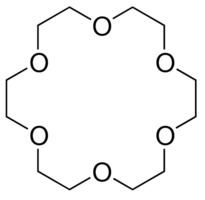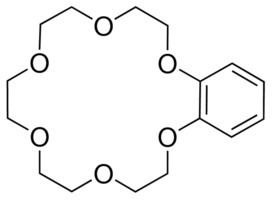Molar mass 264.122 g/mol Boiling point 116 °C | Formula C12H24O6 Density 1.24 g/cm³ | |
 | ||
Related compounds | ||
K 18 crown 6 ether shortest weighted ensemble dissociation
18-Crown-6 is an organic compound with the formula [C2H4O]6 and the IUPAC name of 1,4,7,10,13,16-hexaoxacyclooctadecane. It is a white, hygroscopic crystalline solid with a low melting point. Like other crown ethers, 18-crown-6 functions as a ligand for some metal cations with a particular affinity for potassium cations (binding constant in methanol: 106 M−1). The point group of 18-crown-6 is S6. The dipole moment of 18-crown-6 varies in different solvent and under different temperature. Under 25 °C, the dipole moment of 18-crown-6 is 2.76 ± 0.06 D in cyclohexane and 2.73 ± 0.02 in benzene. The synthesis of the crown ethers led to the awarding of the Nobel Prize in Chemistry to Charles J. Pedersen.
Contents
Synthesis

This compound is prepared by a modified Williamson ether synthesis in the presence of a templating cation: It can be also prepared by the oligomerization of ethylene oxide:
(CH2OCH2CH2Cl)2 + (CH2OCH2CH2OH)2 + 2 KOH → (CH2CH2O)6 + 2 KCl + 2 H2O
It can be purified by distillation, where its tendency to supercool becomes evident. 18-Crown-6 can also be purified by recrystallisation from hot acetonitrile. It initially forms an insoluble solvate. Rigorously dry material can be made by dissolving the compound in THF followed by the addition of NaK to give [K(18-crown-6)]Na, an alkalide salt. Crystallographic analysis reveals a relatively flat molecule but one where the oxygen centres are not oriented in the idealized 6-fold symmetric geometry usually shown. The molecule undergoes significant conformational change upon complexation.
Reactions

18-Crown-6 has a high affinity for the hydronium ion H3O+, as it can fit inside the crown ether. Thus, reaction of 18-crown-6 with strong acids gives the cation [H3O⊂18-crown-6]+. For example, interaction of 18-crown-6 with HCl gas in toluene with a little moisture gives an ionic liquid layer with the composition [H3O⊂18-crown-6]+[HCl2]−·3.8 C6H5Me, from which the solid [H3O⊂18-crown-6]+[HCl2]− can be isolated on standing. Reaction of the ionic liquid layer with two molar equivalents of water gives the crystalline product (H5O2)[H3O⊂18-crown-6]Cl2.
18-Crown-6 binds to a variety of small cations, using all 6 oxygens as donor atoms. Crown ethers can be used in the laboratory as phase transfer catalysts. For example, potassium permanganate dissolves in benzene In the presence of 18-crown-6, giving the so-called "purple benzene", which can be used to oxidize diverse organic compounds.
Various substitution reactions are also accelerated in the presence of 18-crown-6, which suppresses ion-pairing. The anions thereby become naked nucleophiles. For example, using 18-crown-6, potassium acetate is a more powerful nucleophile in organic solvents:
[K(18-crown-6)+]OAc− + C6H5CH2Cl → C6H5CH2OAc + [K(18-crown-6)+]Cl−The first electride salt using 18-crown-6 that has been synthesized and examined with X-ray crystallography is [Cs(18-crown-6)2]+·e− in 1983. This highly air- and moisture-sensitive solid has a sandwich molecular structure, where the electron is trapped within nearly spherical lattice cavities. However, the shortest electron-electron distance is too long (8.68 Å) to make this material a conductor of electricity.
